Memorials and Memory on a French Quarter Dog Walk

My wife and I, along with our spunky mutt Mouton (named after General Jean-Jacques-Alfred- Alexandre Mouton), spent the week before Christmas 2021 in New Orleans. My younger sister got married that week and we were sure to not miss out. Throughout the festivities, we stayed at my uncle’s house in the Faubourg Marigny, just to the east of the Crescent City’s famous French Quarter. It is a quaint neighborhood packed with shotgun houses, structures split down the middle to form two domiciles. Each day I took some time to walk Mouton down the picturesque streets of the Marigny and French Quarter, which surprisingly brought us on a tour of some of New Orleans’ most important pieces of memory related to the Civil War era.
We started by heading west on Royal Street, quickly passing Washington Square Park, land preserved as a public space when the Marigny was first developed from plantations. Today it is listed on the National Register of Historic Places. Reaching Esplanade Avenue, the border between the Marigny and French Quarter, Mouton and I turned left, southbound toward the Mississippi River.
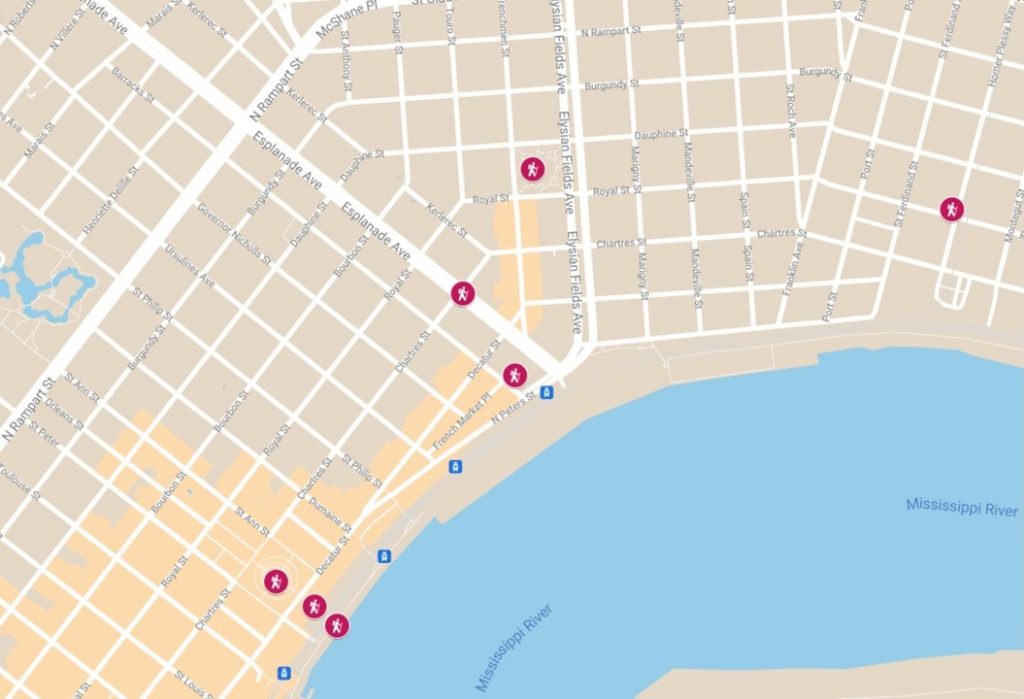
A block down, where Chartres Street meets Esplanade Avenue, we saw a pair of historic signs and stopped. One displays an old map of the local area with red dots. This intersection was the focal point for enslavement within the city, packed with the auction houses that sold enslaved persons, cells and pens that forcibly housed them, and the firms that facilitated this trade. The other sign here explains that Solomon Northup was kept here before being forcibly sold and moved to central Louisiana.
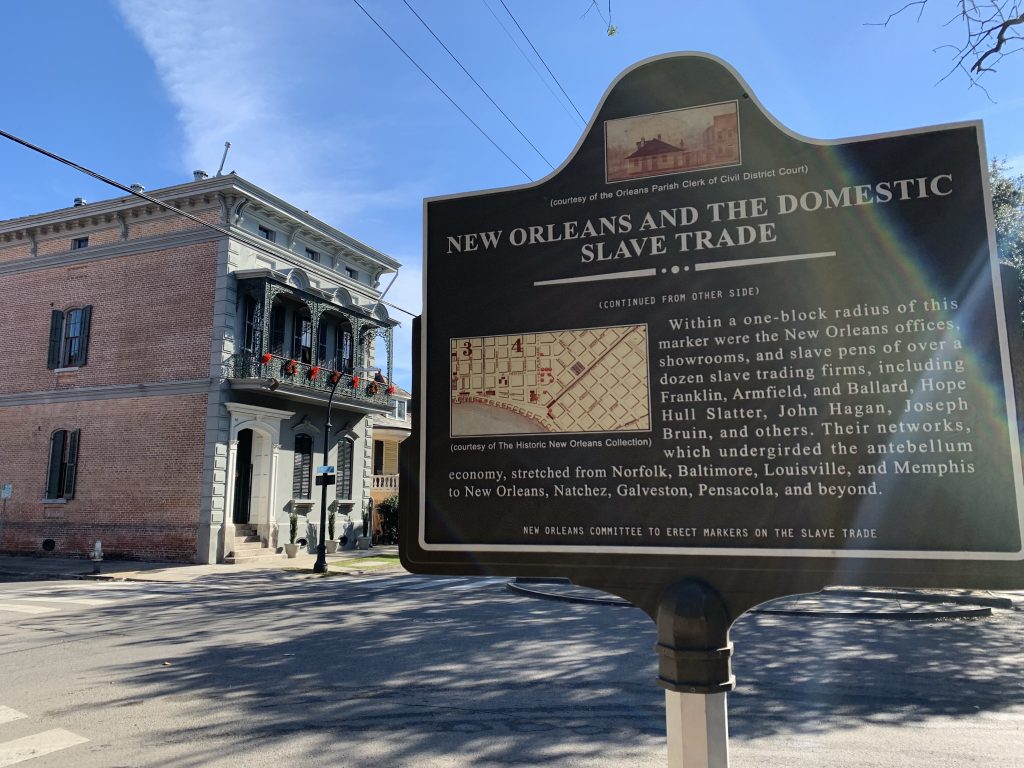
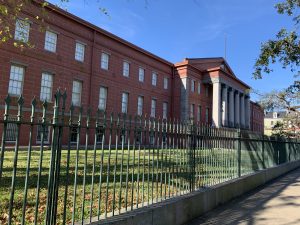
Mouton and I continued down Esplanade Avenue to the old United States mint at the street’s terminus with the Mississippi. Today the old mint is the site of the New Orleans Jazz Museum, but in 1862, it was where William Mumford ripped down a U.S. flag hoisted when David Farragut and Benjamin Butler assumed control over the city. Mumford was convicted by a military court for treason and hanged in the mint’s courtyard.
From the mint, we strolled along the Mississippi’s boardwalk, the site where David Farragut’s squadron anchored after passing the river’s forts below. Reaching the middle of the boardwalk, we were surprised to find another historical marker, this one highlighting the role of New Orleans as part of the Transatlantic Slave Trade.
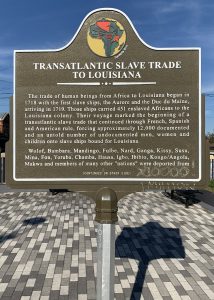
Turning north from the boardwalk, I gazed upon Jackson Square, the center of the French Quarter. Before entering that historic site however, there was another Civil War monument blocking our path. This was Washington Artillery Park. Most visitors to the city know this as the amphitheater of stairs where locals perform and tours meet, just next to Café Du Monde. At the top of that amphitheater however, is a single 1861 Parrott rifled cannon lined with placards. These tell the story of the most famous Louisiana military unit, the Washington Artillery. Organized in 1838, the artillery company fought in the U.S.-Mexican War. As the Civil War escalated, it expanded to five companies. Four saw service as a battalion in the Army of Northern Virginia, serving in that army’s major campaigns, famously helping defend Mayre’s Heights at the Battle of Fredericksburg. The fifth company fought in the Army of Tennessee.
After the Civil War, the Washington Artillery became a fraternal organization, but reorganized as a National Guard unit, serving in the Spanish American War, the 1916 Mexican border conflicts, World War One, World War Two, and the War on Terror. It has also worked in humanitarian assistance and disaster response missions for Louisiana, helping prepare the state for hurricanes.
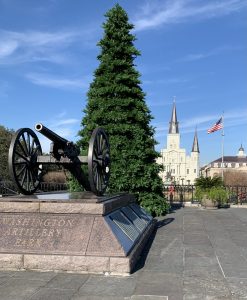
Washington Artillery Park’s numerous placards were installed in 1976, to commemorate the bicentennial of the United States, and were updated in the 1990’s. The signs surrounding the Parrott rifle tell the history of the organization, including its Civil War service. Because of its linkage to a Confederate military unit, the park has recently been identified for possible reclassification by the New Orleans Street Renaming Commission. They have recommended renaming the park for Oscar Dunn, the first African American elected as Louisiana’s lieutenant governor in 1868, though no final action has been taken by the New Orleans City Council as of yet.[i] As a final personal connection, I proposed to my wife Brittany at Washington Artillery Park, overlooking Jackson Square, on Christmas night, 2010, right next to the large Christmas tree erected in the park each year.
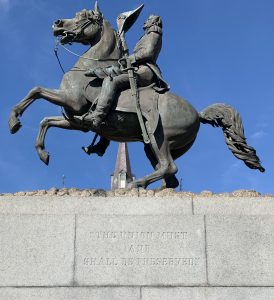
Mouton and I next proceeded down Washington Artillery Park’s amphitheater to Jackson Square. Named to honor President Andrew Jackson, who defended the city against British incursions in the War of 1812, a large statue of Jackson stands in the square’s center. This also has a subtle Civil War connection. In 1862, General Benjamin Butler had a Jackson quote carved directly into the statue: “The Union Must and Shall be Preserved.” These seven words symbolized the determination of the United States to maintain control over the Crescent City and extinguish its’ internal rebellion.
From Jackson Square, Mouton and I zig-zagged up Chartres and Royal Streets, where we turned east to return to the Faubourg Marigny, passing at least one building dating back to the eighteenth century where renovated slave and servant quarters were clearly visible in a courtyard behind a main home. There was one final historical marker to see on our dog walk-turned tour. The last was a single sign in the Marigny, on the corner of Royal Street and Homer Plessy Way, at the site of the old Press Street railroad station. This marker commemorates where Homer Plessy was arrested in 1892 for purposefully violating Louisiana’s Separate Car Act, challenging legalized segregation laws. Though Plessy’s case ultimately failed, it inspired others to later act, eventually shattering legalized segregation in the United States.

A host of other historical sites tied to the Civil War era were not on our walk. There is also Congo Square, the site just outside the norther edge of the French Quarter where enslaved persons gathered each week. There is Confederate Memorial Hall, one of the oldest and largest collections of Confederate wartime artifacts. There are also battlefield fortifications around the city and its outskirts, as well as statues and monuments dotting cemeteries across town.
New Orleans has made news in recent years for removing historical monuments of Jefferson Davis, Robert E. Lee, P.G.T. Beauregard, and a monument commemorating “white supremacy” and the Battle of Liberty Place.[ii] My stroll through the Marigny and French Quarter with my spirited dog Mouton have shown however, that the Civil War era’s memory is still quite alive in the most historic parts of the Crescent City, all within the stretch of a dog walk.
Endnotes:
[i] Jeff Adelson, “These Two New Orleans parks could be renamed soon; no opposition in public forums,” NOLA.com, May 27, 2021, https://www.nola.com/news/politics/article_12d2312a-bf54-11eb-bcd8-eff10fc7f300.html.
[ii] Gordon Chadwick, “The Creation of the Battle of Liberty Place Monument,” New Orleans Historical, accessed December 27, 2021, https://neworleanshistorical.org/items/show/150.
Very enjoyable and historic tour. You’ve got one smart dog.
I’ve only ventured into the French Quarter one time – Cafe Du Monde was crazy busy so I had to find another coffee shop! – and the architecture is simply gorgeous. You can really see the blend of French, Spanish, and American influences on just about every street. I was like a kid at Christmas! Just in awe of everything!
The quote on Jackson’s statue is interesting, in that it harkens back to the Nullification Crisis with South Carolina in the 1830s. I think Jackson said something similar to the inscription Butler commissioned. It became just one of the many warning signs of coming disunion and sectional animosity.
Absolutely love the city and all its history! I wish I could visit more often. Thanks for sharing about your walks!
I know what you mean. Walking the French Quarter and just taking some time to soak in everything is one of my favorite things to do when I am in New Orleans.
Love NOLA! It was the only big city I ever visited much as a kid being a native Louisianian. History galore.
I was just reading up on Pierre Soulé, a French born New Orleanian, who was an antebellum US Senator from Louisiana and a US diplomat famous/infamous for the Ostend Manifesto. Soulé, as you know, was the Louisiana Senator who acted on the request of freedom for Solomon Northup. It was Soulé who wrote to the local sheriff in Avoyelles Parish to go and remove Northup from enslavement. Soulé was himself a slave owner.
As an addition, the post went up on the exact day that Homer Plessy was officially pardoned by the governor of Louisiana. Governor John Bel Edwards issued the pardon at the Press Street Station, pictured above in the text.
https://www.cnn.com/2022/01/05/us/plessy-pardon-signed-by-governor/index.html
Nice post. Gen. Butler was what we would describe today as a bully, but he had some of the right sentiments.
Tom
Something to update regarding this tour posting. On August 16, 2022 the cannon at the Washington Artillery Park was removed and relocated to the museum at the New Orleans Jackson Barracks. The park itself is being renamed Oscar Dunn Park, just as was mentioned in the original posting. Something to consider is that the 141st Field Artillery of the Louisiana National Guard (which is the modern military unit designation for the National Guard force that was the Washington Artillery of the Louisiana Militia in the 19th century) is headquartered at Jackson Barracks, so relocating the cannon there can be seen as returning the cannon (which was actually one used by the Washington Artillery) to its home unit.
https://www.wdsu.com/article/new-orleans-jackson-square-cannon-removed/40922341